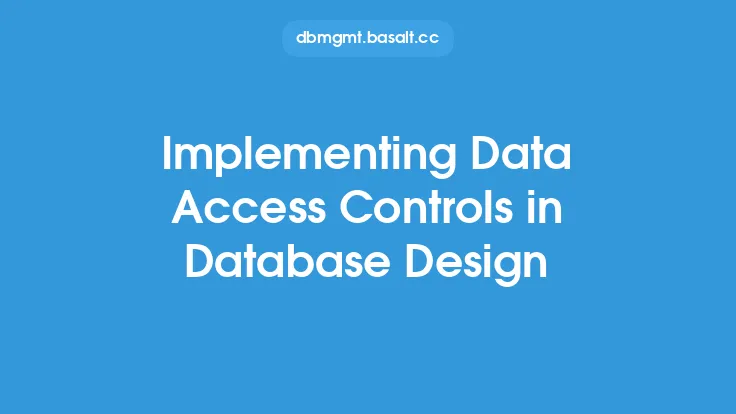Data stewardship is a critical component of database design, ensuring that data is accurate, reliable, and secure. It involves a set of roles and responsibilities that are essential for maintaining the integrity and quality of data within an organization. In this article, we will delve into the world of data stewardship, exploring the various roles and responsibilities involved in this process, and how they contribute to the overall design and management of a database.
Introduction to Data Stewardship
Data stewardship is the process of managing and overseeing the data assets of an organization. It involves a range of activities, including data quality management, data security, data governance, and data compliance. The primary goal of data stewardship is to ensure that data is accurate, complete, and consistent, and that it is available to authorized users in a timely and efficient manner. Data stewards are responsible for ensuring that data is properly managed and maintained, and that it is used in a way that is consistent with the organization's goals and objectives.
Data Stewardship Roles
There are several key roles involved in data stewardship, each with its own set of responsibilities and requirements. These roles include:
- Data Steward: The data steward is responsible for overseeing the management of data assets within an organization. This includes ensuring that data is accurate, complete, and consistent, and that it is available to authorized users in a timely and efficient manner.
- Data Owner: The data owner is responsible for the overall management and maintenance of a specific dataset or data asset. This includes ensuring that data is properly documented, and that it is stored and managed in a secure and efficient manner.
- Data Custodian: The data custodian is responsible for the day-to-day management of data assets, including data storage, data backup, and data recovery.
- Data User: The data user is responsible for using data in a way that is consistent with the organization's goals and objectives. This includes ensuring that data is used in a manner that is compliant with relevant laws and regulations.
Data Stewardship Responsibilities
Data stewards have a range of responsibilities, including:
- Data Quality Management: Data stewards are responsible for ensuring that data is accurate, complete, and consistent. This includes identifying and correcting data errors, and implementing data quality controls to prevent errors from occurring in the future.
- Data Security: Data stewards are responsible for ensuring that data is properly secured, and that access to data is restricted to authorized users. This includes implementing data encryption, access controls, and other security measures to protect data from unauthorized access or theft.
- Data Governance: Data stewards are responsible for ensuring that data is managed and maintained in a way that is consistent with the organization's goals and objectives. This includes developing and implementing data governance policies and procedures, and ensuring that data is used in a manner that is compliant with relevant laws and regulations.
- Data Compliance: Data stewards are responsible for ensuring that data is managed and maintained in a way that is compliant with relevant laws and regulations. This includes ensuring that data is properly documented, and that it is stored and managed in a secure and efficient manner.
Data Stewardship in Database Design
Data stewardship plays a critical role in database design, ensuring that data is properly managed and maintained throughout the database lifecycle. This includes:
- Data Modeling: Data stewards are involved in the data modeling process, ensuring that data is properly defined and structured to meet the needs of the organization.
- Data Normalization: Data stewards are responsible for ensuring that data is properly normalized, to minimize data redundancy and improve data integrity.
- Data Storage: Data stewards are responsible for ensuring that data is properly stored and managed, including the selection of appropriate data storage solutions and the implementation of data backup and recovery procedures.
- Data Access: Data stewards are responsible for ensuring that data is properly secured, and that access to data is restricted to authorized users. This includes implementing data encryption, access controls, and other security measures to protect data from unauthorized access or theft.
Best Practices for Data Stewardship
There are several best practices that organizations can follow to ensure effective data stewardship, including:
- Establish Clear Roles and Responsibilities: Organizations should establish clear roles and responsibilities for data stewards, data owners, data custodians, and data users.
- Develop Data Governance Policies: Organizations should develop data governance policies and procedures to ensure that data is managed and maintained in a way that is consistent with the organization's goals and objectives.
- Implement Data Quality Controls: Organizations should implement data quality controls to ensure that data is accurate, complete, and consistent.
- Provide Training and Support: Organizations should provide training and support to data stewards, data owners, data custodians, and data users to ensure that they have the skills and knowledge needed to effectively manage and maintain data assets.
- Monitor and Evaluate Data Stewardship: Organizations should regularly monitor and evaluate data stewardship activities to ensure that they are effective and efficient, and to identify areas for improvement.
Conclusion
Data stewardship is a critical component of database design, ensuring that data is accurate, reliable, and secure. By understanding the roles and responsibilities involved in data stewardship, organizations can ensure that their data assets are properly managed and maintained, and that they are used in a way that is consistent with the organization's goals and objectives. By following best practices for data stewardship, organizations can ensure that their data is properly governed, and that it is used to drive business success.





